Kigelia
Kigelia is a genus of flowering plants in the family Bignoniaceae. The genus consists of only one species, Kigelia africana, which occurs throughout tropical Africa. The so-called sausage tree grows a poisonous fruit that is up to 60 cm (2 feet) long, weighs about 7 kg (15 pounds), and resembles a sausage in a casing.
| Kigelia | |
|---|---|
 | |
| K. africana habit, fruit, flower and seeds | |
| Scientific classification | |
| Kingdom: | Plantae |
| Clade: | Tracheophytes |
| Clade: | Angiosperms |
| Clade: | Eudicots |
| Clade: | Asterids |
| Order: | Lamiales |
| Family: | Bignoniaceae |
| Clade: | Crescentiina |
| Clade: | Paleotropical clade |
| Genus: | Kigelia DC. |
| Species: | K. africana |
| Binomial name | |
| Kigelia africana | |
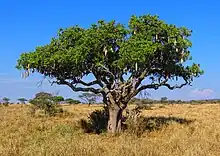
Etymology
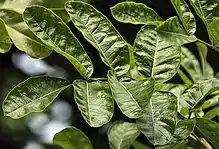
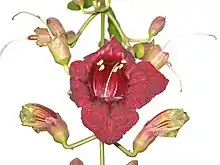

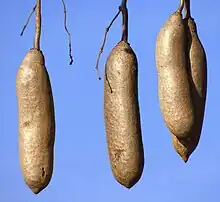
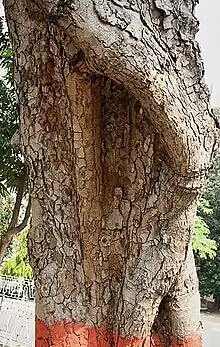
The genus name comes from the Mozambican Bantu name, kigeli-keia, while the common names sausage tree and cucumber tree[1] refer to the long, sausage-like fruit. Its name in Afrikaans worsboom also means sausage tree, and its Arabic name means "the father of kit-bags".[2]
Description
It is a tree growing up to 20 m (66 feet) tall and it typically has spreading branches. The bark is grey and smooth at first, peeling on older trees. It can be as thick as 6 mm (1⁄4 inch) on a 15-centimetre (5.9 in) diameter branch.[2] The wood is pale brown or yellowish, undifferentiated and not prone to cracking.[2]
Foliage
The tree is evergreen in regions where rainfall occurs throughout the year, but deciduous where there is a long dry season. The leaves are opposite or in whorls of three, 30 to 51 cm (12 to 20 inches) long, pinnate, with six to ten oval leaflets up to 20 cm (8 inches) long and 5.7 cm (2+1⁄4 inches) in diameter,the terminal leaflet can be either present or absent.
Flowers
The flowers hang down from branches on long flexible stems (2–6 m or 7–20 ft long). According to author and nature photographer Winston Williams, these stems, or peduncles, can be up to 7.5 m (25 ft) in length.[3] Flowers are produced in panicles; they are bell-shaped (similar to those of the African tulip tree but broader, darker, and more waxy), orange to maroon or purplish green, and about 10 cm (4 inches) wide. Individual flowers do not hang down but are oriented horizontally.
Fruit
The fruit is a woody berry from 30 to 99 cm (12 to 39 inches) long[4] and up to 18 cm (7 inches) in diameter, but 20 cm (8 inches) has been reported.[5] Typically the fruit weighs between 5 and 10 kg (11 and 22 pounds) but occasionally up to 12 kg (26 pounds),[6] and hangs down on the long, rope-like peduncles. The fruit pulp is fibrous, containing many seeds.
Species associations
Some birds are attracted to the flowers and the strong stems of each flower make ideal footholds. Their scent is most notable at night indicating that they are adapted to pollination by bats, which visit them for pollen and nectar. The flowers remain open during the day, and are freely visited by many insect pollinators, particularly large species such as carpenter bees. The fruit are eaten by several species of mammals, including baboons, bushpigs, savannah elephants, giraffes, hippopotamuses, monkeys, and porcupines. The seeds are dispersed in their dung. The seeds are also eaten by brown parrots and brown-headed parrots, and the tree's foliage by elephants and greater kudu (Joffe 2003; del Hoyo et al. 1997). Introduced specimens in Australian parks are very popular with cockatoos.
Cultivation and uses
The fresh fruit is poisonous to humans and strongly purgative. The fruits are prepared for consumption by drying, roasting, or fermentation (Joffe 2003; McBurney 2004). In Botswana, the timber is used for makoros, yokes and oars.[2]
The hard shell (skin) of the fruit can be hollowed out, cleaned, and made into useful, durable containers of varying sizes.
Around Mount Kenya, especially among the Kikuyu, Embu and the Akamba, the dried fruits are used to make an alcoholic beverage (muratina in Kikuyu, Aembu and kaluvu in Kamba), which is a core component in cultural events in central Kenya. The fruit is harvested, split into two along the grain, before being dried in the sun. The dried fruits are then inserted into a fermentation vessel with older, in-use muratina (prural) to activate and inoculate the new ones with yeast. The more the cultures are used, the more potent they become in converting sugars from sugarcane juice and honey to carbon dioxide and alcohol. The alcoholic drink is usually reserved for special occasions like weddings, dowry and burial ceremonies.
The tree is widely grown as an ornamental tree in tropical regions for its decorative flowers and unusual fruit. Planting sites should be selected carefully, as the falling fruit can cause serious injury to people and damage vehicles parked under the trees.
Gallery
 Detail of bark of the sausage tree
Detail of bark of the sausage tree Developing flower
Developing flower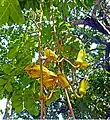 Sausage tree inflorescence
Sausage tree inflorescence Fallen sausage tree flower corollas
Fallen sausage tree flower corollas Fruit of a sausage tree
Fruit of a sausage tree


 A sausage tree in Botswana in use as an airport departure lounge
A sausage tree in Botswana in use as an airport departure lounge Seeds and husk of a broken fruit, Pune, India.
Seeds and husk of a broken fruit, Pune, India. Kigelia africana – sausage tree
Kigelia africana – sausage tree Kigelia africana with unripe fruits: campus of UWI, Trinidad, Feb. 2015
Kigelia africana with unripe fruits: campus of UWI, Trinidad, Feb. 2015 Kigelia africana: campus of U. West Indies, Trinidad, Feb. 2015
Kigelia africana: campus of U. West Indies, Trinidad, Feb. 2015.JPG.webp) Entryway at the Lincoln Park Conservatory in Chicago, Il
Entryway at the Lincoln Park Conservatory in Chicago, Il.jpg.webp)
.jpg.webp)
References
- Sangita Saini; Harmeet Kaur; Bharat Verma; Ripudaman & S. K. Singh (2009). "Kigelia africana (Lam.) Benth. — an overview" (PDF). Natural Product Radiance. 8 (2): 190–197.
- Roodt, Veronica (1992). Kigelia africana in The Shell field guide to the common trees of the Okavango Delta and Moremi Game Reserve. Gaborone, Botswana: Shell Oil Botswana.
- Williams, Winston. Florida's Fabulous Trees. Tampa: Worldwide Publications. p. 24.
- Huxley, Anthony. The New Royal Hort. Soc. Dictionary of Gardening. Vol. 2. New York: Stockton Press. p. 735.
- Lindley, John and Thomas Moore (1866). A Treasury of Botany. Vol. 2. London: Longmans, Green & Co. p. 647.
- Vandaveer, Chelsie (March 7, 2002). "Killer Plants". Archived from the original on 15 June 2010. Retrieved 14 December 2004.
Bibliography
- del Hoyo, J., Elliott, A., & Sargatal, J., eds. (1997). Handbook of the Birds of the World 4: 415. Lynx Edicions.
- Huxley, A., ed. (1992). Kigelia. In The New RHS Dictionary of Gardening 2: 735. Macmillan.
- Joffe, P. (2003). PlantZAfrica: Kigelia africana.
- McBurney, R. (2004). African Wild Harvest. Royal Botanic Gardens, Kew.